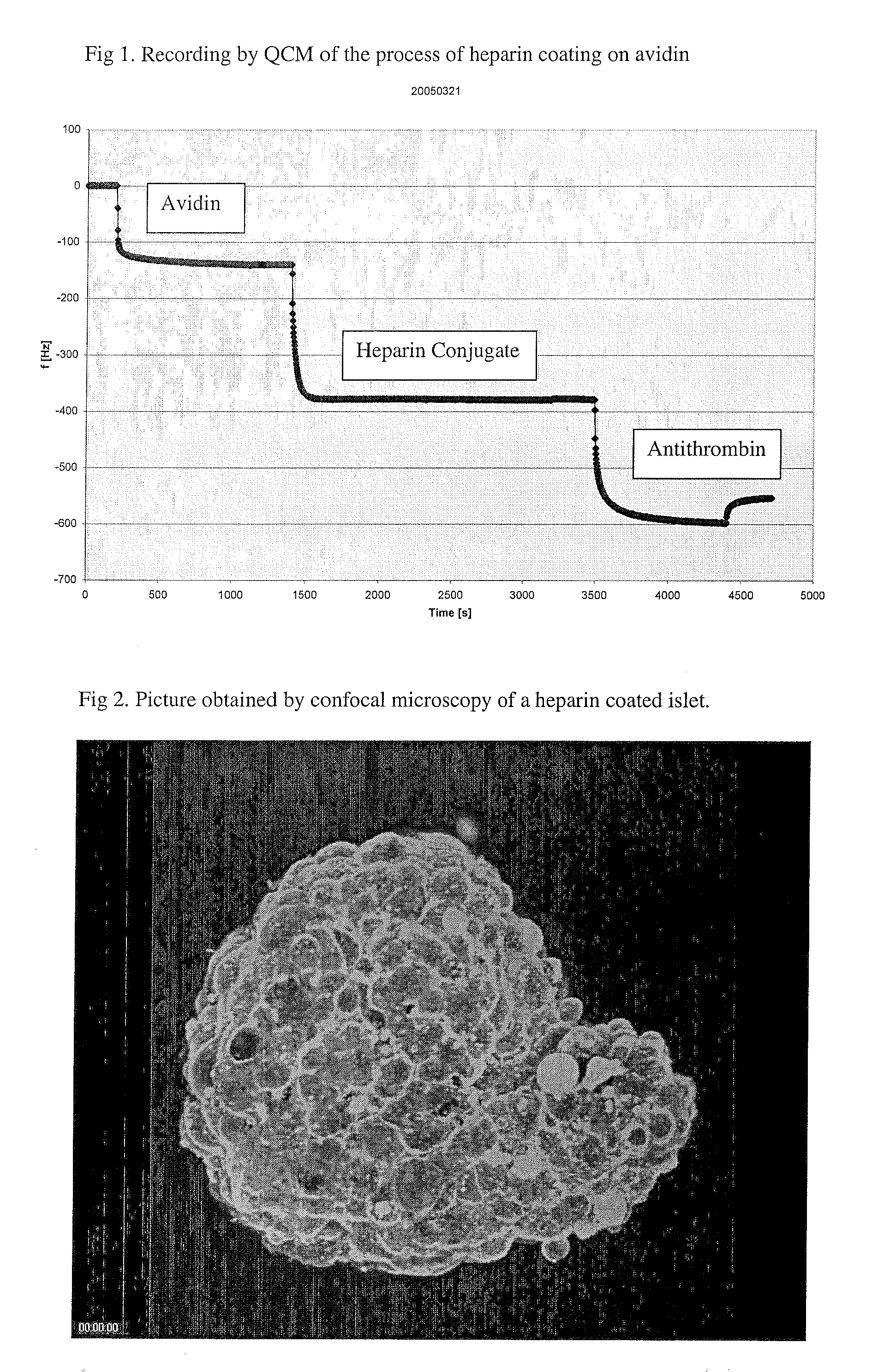Heparin coating of biological tissue
a biological tissue and heparin technology, applied in the field of in vitro, can solve the problems of difficulty in reproducibility and lack of teaching in patents, and achieve the effect of reproducibility, improving biocompatibility and biological function of biological tissu
- Summary
- Abstract
- Description
- Claims
- Application Information
AI Technical Summary
Benefits of technology
Problems solved by technology
Method used
Image
Examples
example 1
Demonstration of the Effect by Avidin in the Formation of Heparin Coating
[0021]The following example was designed to illustrate the importance of including avidin in the coating protocol. An artificial surface, illustrated by PVC tubings, was coated with albumin to mimic a biological substrate.
[0022]PVC tubings were coated with albumin by passive adsorption by circulating a saline solution containing 2% albumin for 30 minutes at room temperature. Four groups of tubings were then incubated with three different concentrations of SPDP (N-succinimidyl 3-(2-pyridyldithio)propionate, Perbio Europe). The SPDP bound to the surface was reduced by incubation with an aqueous solution containing DTT (dithiotrietol) in order to convert the surface bound SPDP to free sulfhydryl groups. The relative occurrence of free sulfphydryl groups was measured by recording the change in absorbance at 340 nm. According to Table 1, a proportional increase of free sulfhydryl groups with increasing concentration...
example 2
Investigation of the Heparin Coating on Islets of Langerhans Using Confocal Microscopy
[0024]Human islets of Langerhans were isolated according to standard procedure and kept in culture medium. A portion of islets was first incubated with biotin (EZ Link™ Sulfo-NHS-LC-Biotin, Perbio, 1 mg / ml) for 60 minutes at room temperature and then rinsed with three volumes of fresh medium. The islets were then incubated in avidin (1 mg / ml) for 30 minutes at room temperature and then again rinsed with three volumes of medium. The last incubation was performed with the heparin conjugate from Corline, Sweden, (1 mg / ml) for 60 minutes at room temperature and a final rinsing with three volumes of medium. After staining with fluorescently labelled antithrombin the heparin modified islets were compared with non-modified islets using a confocal microscope. A coherent layer of fluorescently labelled antithrombin was observed on the heparin-modified islets, as shown in FIG. 2.
example 3
Effect on IBMIR (Instant Blood Mediated Inflammatory Response) by Heparin Modified and Non-Modified Human Islets of Langerhans
[0025]Human islets of Langerhans were isolated according to standard procedure and kept in culture medium and modified with the heparin conjugate from Corline, Sweden, as previously described in Example 2 using three different types of biotin reagents (EZ-Link™ Sulfo-NHS-LC-Biotin or EZ-Link™ Sulfo-NHS-LC-LC-Biotin or EZ-Link™ TFP-PEO-Biotin). The heparin modified islets were compared with non-modified islets using the Chandler loop model, described elsewhere (Diabetes, 48, 1907-1914, 1999). Briefly, human blood without anticoagulant but supplemented with non-modified or heparin modified islets was rocked in heparin coated tubing loops at 37° C. for up to one hour. The non-modified islets provoked macroscopic clotting and the platelet count was reduced to less than five percent of the baseline level according to the Chandler loop model. There was no macroscop...
PUM
| Property | Measurement | Unit |
|---|---|---|
| temperature | aaaaa | aaaaa |
| concentration | aaaaa | aaaaa |
| affinity | aaaaa | aaaaa |
Abstract
Description
Claims
Application Information
 Login to View More
Login to View More - R&D
- Intellectual Property
- Life Sciences
- Materials
- Tech Scout
- Unparalleled Data Quality
- Higher Quality Content
- 60% Fewer Hallucinations
Browse by: Latest US Patents, China's latest patents, Technical Efficacy Thesaurus, Application Domain, Technology Topic, Popular Technical Reports.
© 2025 PatSnap. All rights reserved.Legal|Privacy policy|Modern Slavery Act Transparency Statement|Sitemap|About US| Contact US: help@patsnap.com

